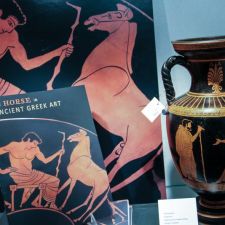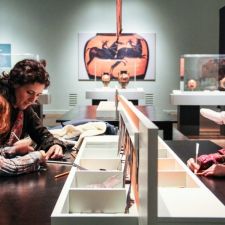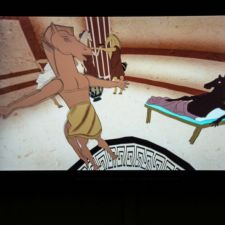The exhibition, which opened February 17, 2018, includes black-and-red-figure vases,
and silver coins displaying images of horses in ancient Greece. From legends and
myths, such as Pegasos, the winged horse; to the horse in war and hunting; and
equestrian sports; the horse was an important part of ancient Greek culture. The
beauty and grace of the horse inspired the ancient Greek artists. The horse was a
symbol of wealth, power, and status. Ancient tack, such as bits, illustrate the
equestrian life.
This free exhibition is on the second floor of the Virginia Museum of Fine Arts in
Richmond. Walk through large glass doors to the Evans Court and turn right into the
exhibit “The Horse in Ancient Greek Art” . The gallery exhibits ancient vases and
objects, which the ancient Greeks used to celebrate the horse in their lives. The horse
was used as transportation, hunting, racing, and war.
From the ceiling and the walls of the galleries are hangings with enlarged images
copied from the vases. The terracotta vases and cups are created from iron-rich clay.
The redish-orange color is the natural color of the clay. The black color is diluted clay
which turns black during the firing process of the pottery. The entire space exists in
orange, black and white colors. Reminds me of halloween. Two long tables hold
colored pencils and selections of paper cutouts of horses, griffins, etc. which children
and adults are encouraged to color. Your decorated cutout can be displayed are taken
home.
The large decorated vases, filled with olive oil, were awarded as prizes for athletic
competitions. The most famous were the Olympics. The ancient Olympic games were
founded around 776 BCE. Equestrian events, such as chariot racing, were introduced
in the Seventh Century.
A small area has small tables and lounge couches to represent a Greek symposium.
This was where Greek men gathered to drink wine, discuss politics, tell stories, and be
entertained with music and poetry. A perfect place to relax and browse the exhibition
catalogue or listen to an audio.
“The Horse in Ancient Greek Art” in-gallery activities are touch screen animations,
videos, hand-on activity and a poem by Virginia poet Ron Smith. On one wall are two
screens which show videos designed by VCU students. One video is a twirling large
vase. The other screen is an animated video of of a Greek symposium which uses
horses instead of men.
Dr. Peter Schertz and Nicole Stribling, the co-curators of the exhibition, write about
hippomania (a passion for horses), which was prevalent in ancient Greece.
Hippomania is also present in Goochland County.




Recent Comments